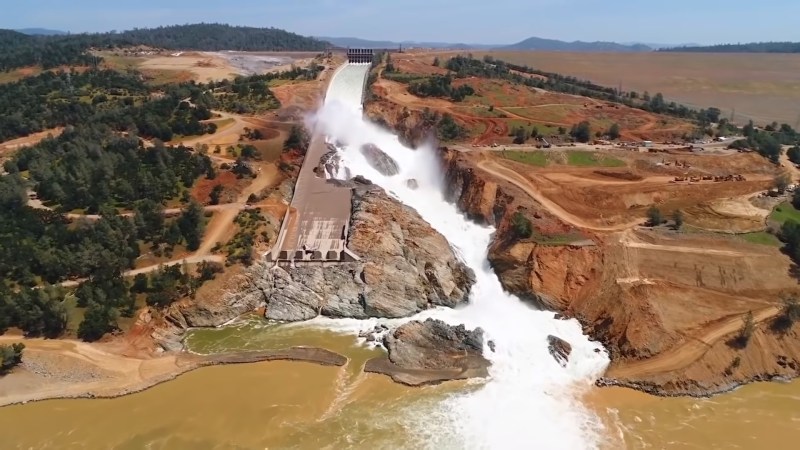Back when it first happened, we covered the Oroville Dam near-disaster. Heavier-than-expected rainfall in California back in early 2017 led to running the dam’s primary spillway at much higher-than-normal levels. February 17, 2017, the operators noticed something odd about the water flow down the spillway, and when they turned off water flowing down the spillway, it was made obvious that they had a major problem on their hands. Several chunks of concrete were missing, and the water had begun gouging into the earth beneath the spillway. It would need repairs before it was properly up to the task of discharging water, but it was still raining.
The rising water level in Lake Oroville put operators in a tricky situation, as they needed to discharge water in the least damaging way possible. They decided to use the emergency spillway to keep water levels at safe levels. Unfortunately, the secondary spillway began to deteriorate even more quickly than the primary had, and continued use could compromise the structure of the entire dam. The difficult decision was made to evacuate downstream residents, and sacrifice the primary spillway to drain the lake to 50 feet below the nominal full level. It worked, and effectively destroyed the bottom two-thirds of the spillway over those 3 months.
With the water at a safe level, the spillways could be repaired, a monumental nearly-2-year process in itself. We’ve covered all this before, but you may be left with the nagging question, what went wrong? [Grady Hillhouse], of the Practical Engineering channel, breaks it down for us in the video embedded below.
The short answer is that the dam was designed and maintained with the assumption that the spillways were built on bedrock — even though it was discovered during construction that reality was not that simple. Cracks in the concrete allowed water to seep between the individual slabs, and that water slowly worked against the structure. Some of the safeguards built in to the spillway were installed incorrectly, and the state-of-the-art has advanced significantly since the dam was built in 1961. The report Grady pulled information from is freely available, so go check it out for yourself for all the details.















I just finished reading Floodpath, by John Wilkman. It’s a very comprehensive history of the St. Francis Dam disaster, which in lives lost was the second largest in California history. Highly recommended.
The Late, Great State of California. Another good read.
I love a good educational video. Thanks Grady.
Engineering wasn’t the problem. As ALWAYS, government was and is, and is impeding the repair.
Great video, thanks !
Agree!
Probably a few thousand dollars a year preventative maintenance could have kept it functioning for a few centuries. Something as simple as weekly inspections (With photographs to track changes) and a layer of waterproof paint applied to 30% of the area every other year or some molten tar to form a low friction waterproof barrier on the surface of the concrete. It is not rocket science it is basic fluid mechanics which is part of the syllabus for civil engineers (thought as Hydraulics).
What the spillway needed before it failed was super cleaning the concrete, sandblasting, then a coating of spray on polyurethane with glass fiber mesh reinforcing embedded.
I watched the video a while ago and the way some of the things were done should have been obviously bad back in the 1960’s. Who in their right mind would ever expect flat butt joints between concrete slabs to work at all with huge amounts of water flowing over them? They should have been made like an offset lap joint so that water would have to flow uphill to get through.
Instead they just figured on allowing leaks and installed permeable drains crosswise, with each drain piped to dump holes lower down on the walls. That’s where all the water comes from shooting into the spillway from the walls.
Even worse, instead of cutting channels into the base for the drains, they laid the drains on top and cast the concrete over them, making thinner, weaker spots over every drain.
In the 1960’s they could have coated it with a thick layer of glass reinforced epoxy heavily pigmented with titanium dioxide to reflect light for ultraviolet protection. That would also have served to seal the joints.
Anything that would serve to minimize or better yet prevent water getting through the joints, along with not screwing up the design of the drains, would have kept the spillway from collapsing. They had the technology, they just chose to not apply it.
During the last FERC Dam licensing hearings fishery and environmental groups submitted in writing concerns about the emergency spillway engineering. The big water contractors lobbied heavily to overide those concerns because they would legally be on the hook for any upgrades. So the dam spillways failed as predicted. Under the terms of their contracts, the big water contractors are on the hook for repairs. Guess who got illegally stuck with the massive repair bill. You guessed it, state and federal taxpayers
Best review of the Oroville dam situation throughout the failure and repair was presented by Juan Browne on his YouTube channel: https://youtube.com/playlist?list=PL6SYmp3qb3uMCqXIp7mYmiAPeEVoazpUE